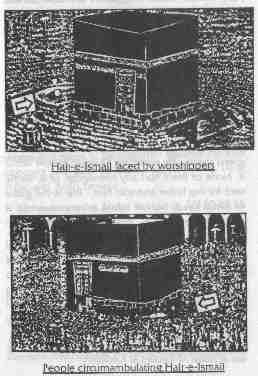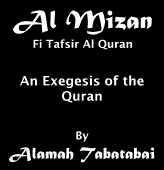
|
| Chapter 3. |
We have already explained in the previous chapter how a particular place becomes blessed or evil without any limitation of time. In this chapter, we shall refer again to the same proofs.
Firstly: From the Book of Allah
Those who consider it permissible to construct tombs over the graves of Prophet and consider them as mosques and places of worship, support their stand with the help of the following ayat:
(1) "Appoint for yourselves a place of
prayer on the standing place of Ibrahim."
(Surah Baqarah 2:125)
(2) They also refer to the incident of the ‘People of the cave’ as mentioned in the Holy Quran:
"Those who prevailed in their affair said: we will certainly raise a masjid over them."
(Sura Kahf 18:21)
The first quotation has already been mentioned by us in our discussion. Bukhari has recorded in his Sahih:
Ismail and Ibrahim (a.s.) were building the Kaaba. Ismail (a.s.) used to bring the stones and Ibrahim (a.s.) set them up. This continued till the structure reached a certain height. In the due course, Ismail (a.s.) brought this stone and Ibrahim (a.s.) stood on it. Ismail continued to pass him the bricks. This place is called as Maqaam-e Ibrahim. This same place has been sanctified and we have been ordered to make it a place of worship.

Another hadith which has come in the Commentaries of the Holy Quran is as follows:-
The People of the Cave were certain subjects of King Daqiyanoos. Daqiyanoos had claimed Godhood. These young men believed in Allah and fled the country of Dagiyanoos and took refuge in a cave.
The Almighty sealed their ears and made them fall asleep for hundreds of years. Then He woke them up. One of them was sent to the city to purchase some victuals. The people of the city became astonished at the coin which he offered because it belonged to an ancient age. The people of the town were believers1 and when they learnt of the youths who had fled their country for the sake of religion and learnt of the place of their hiding, they rushed towards the cave. But when they reached the cave, the youths refused to return to the city (or meet the people); and prayed to Allah to return them to their previous state and Allah put them back to sleep as if they were again dead. The people of the city had a difference of opinion as to what should be done with them. Those who had the decisive word said that they would build a mosque over the resting place of the people of the cave.
Conclusion
In the first Ayat, the Almighty Allah has ordered us to consider the place where Ibrahim (a.s.) stood as a place of prostration. Therefore, it is not polytheism, rather it is Tawheed and the obedience of Allah. In the second ayat, the Almighty Allah informed us about those believers who had decided to build a mosque over the sleeping place of the believing youths. It would be a place of prostrating before Allah the glorified, and a place of worshipping Him as these people were believers and not polytheists. The Almighty Allah has not denounced their decision.
* * *
Both the above ayats have been mentioned in the book of Allah and explained by the traditions of the Holy Prophet (s.a.w.s.).
Secondly: Referring to the Sunnat of the Prophet (s.a.)
(a) The Messenger of Allah (s.a.w.s.) ordered the visitation of graves after prohibiting it. As it has been recorded in Sahih of Muslim, Nasai, Ibn Majah and Tirmizi and also Muwatta from Buraida, from his father who says,
The Messenger of Allah (s.a.w.s.) said, "I had prohibited you to visit the graves (before). Now you visit them."2
In another hadith of Sunan Abi Dawood is the addition, "Because there is a lesson in visiting the graves". Also, in Sunan Ibne Majah there is a report from Ibne Masud (that Holy Prophet said):
"I had prohibited you to visit the graves. Now you visit them because you achieve piety in this world and it reminds you of the Hereafter."3
(b) Now we shall mention whatever has happened in connection with the graves of the Prophets and Messenger.
Those who circumambulated around the Kaaba used to circumambulate the Hajar (stone of) Ismail and they also used to touch it. It contains the graves of Ismail (a.s.) and Hajra (s.a.), his mother, and all the Islamic scholars agree upon it. It is mentioned in the Sirat of Ibne Hisham (died 218 A.H.), Tarikh of Ibne Athir (died 630 A.H.), Tarikh of Tabari (died 310 A.H.), and Tarikh of Ibne Kathir (died 774 A.H.) that:
"Ismail (a.s.) is buried in Hajr with his mother Hajra."
Ibne Athir says,
"Ismail (a.s.) made a will that he should be buried near the grave of his mother Hajra (s.a.).4
Ibne Saad in Tabaqaat remarks,
"When Ismail (a.s.) was 20 years of age, his mother Hajra (s.a.) died. She was ninety years of age. Ismail (a.s.) died after the death of his father. He was buried in Hajr near his mother Hajra (s.a.). Beyond this is the Holy Kaaba. After this, the report says,
The grave of Ismail (a.s.) is below the ‘Mizaab’ between ‘Rukn’ and ‘Bayt’.5
In Kalais’ ‘Iktifa’ it is mentioned that Hajra (s.a.), Ismail (a.s.) and Nabit the son of Ismail (a.s.) are buried in Hajr.6 In the picture below we can see Hajar-e-Ismail surrounded by the pilgrims and the worshippers.
Ibne Jubair has also mentioned about the graves of Ismail (a.s.) and his mother Hajra (s.a.). He says:
Below the ‘Mizaab’, in the courtyard of Hajr near the wall of the House of Kaaba is the grave of Ismail (a.s.). It is marked by a long green marble, shaped like an arch. A round shaped marble is also fixed and both of them are absolutely marvelous. These stones are dotted and a part of them has yellowed. It resembles a chess pawn inlaid with gold.
Towards it is the ‘Rukn’ of Iraq and there is the grave of Hajra (s.a.), the mother of Ismail (a.s.). It is marked with a green marble. It is 1½ hands in length. The people consider it a blessing to pray at both these places of Hajr. It has been proved to them that these two places are associated with the

Holy House. These two places are built on two holy and purified dead bodies. May Allah illuminate their graves, and those who send salawat upon them may derive blessings. Between these two graves is a distance of 7 hand spans.
Abdur Rehman Ibn Jauzi (died 597 A.H.) has mentioned in his book in the chapter ‘Ayan al Madfoonin bil Haram’ from Safwan bin Abdulla Al Jamhi that he said:
"Ibn Zubair dug a pit and found in it a basket of green stones. He asked the Quraishi people about it. None of them had any knowledge of it. So he sent for my father and told him, ‘This is the grave of Ismail (a.s.). Do not move it from here.’ So it was left untouched."
Ibne Zubair said: The rugged area towards the ‘Rukn’ of Syria contains the graves of the unmarried daughters of Ismail (a.s.).
He says that it is between ‘Meezaab’ and ‘Babal Hajr al Gharbi’ (west).
In the chapter of "The graves of the unmarried daughters of Ismail (a.s.) near Masjidul Haram’ he has quoted from ‘The ancient and recent reports about Makkah’. The author of this book is Abi Abdullah Muhammad bin Ishaq Al Fakihi (died 272 A.H.). It is printed at Beirut in 1414 A.H. He says, "Ibne Zubair said, ‘In this area after which is Rukn of Syria are the graves of the unmarried daughters of Ismail (a.s.).’"
Ibne Abi Umar says that when Sufyan was asked where that place is, he indicated towards the Hajr opposite the Rukn of West. Beyond it is ‘Darul Azla’ and ‘Rukn Yamani’.
It is mentioned by Abdul Razzaq in 5/120 of his book and Arzaqi in the ‘Reports of Makkah’ (Akhbare Makka):
When the people of a prophet used to be destroyed (by Divine Chastisement) he used to come to Makkah and reside there and pray with his companions till the end of their lives. Some of such prophets are Hud, Saleh and Shuyabh (a.s.).
And between ‘Rukn’ and ‘Maqaam’, and towards Zamzam and Hajr are graves of some 99 prophets.
Abu Bakr Al Faqih has related from the Holy Prophet (s.a.w.s.) that he said: "There was no prophet who escaped from his people that he did not come to Makkah and worshipped Allah till he died. And there are the graves of Hud, Shuyab and Saleh and between Zamzam and Maqam and in the Kaaba there are the graves of 300 prophets. Between ‘Rukn Yamani’ and ‘Rukn Aswad’ are the graves of 70 prophets.
* * *
All these above details have been mentioned in the books of Ahle Sunnat. The following statements are found in the books of hadith of Ahlul Bayt (a.s.):
Kulaini (died 329 A.H.) in his book al-Kafi, Sadooq (died 381 A.H.) in Man la Yahzarul Faqih and Ilalush Sharaae of Sadooq, Fayd (died 1089 A.H.) in al-Wafi and Majlisi (died 1111 A.H.) in Beharul Anwaar mention that: In Hajr ... is the grave of Hajra (s.a.) and grave of Ismail (a.s.)
It is also mentioned in these books: "The graves of the Prophets are at Hajr."
Moreover it is recorded in Al-Kafi, Al-Wafi and Behaar that: The unmarried daughters of Ismail (a.s.) are buried at Hajr.
* * *
This was an account of the graves of Prophets in Makkah. Now, we will mention about the graves at places other than Makkah.
----------------1 Refer to the tafsir of this ayat in books of exegesis.
2 Sunan Ibne Majah, Kitabul Janaiz 1:501.s
3 Sunan Ibne Majah, Kitabul Janaiz.
4 Sirat Ibne Hisham 1:6.
Tarikh Tabari 1:352.
Tarikh Ibne Athir 1:89.
Tarikh Ibne Katheer 1:193.
5 Tabaqaat Ibne Saad 1:25.
6 Al Maghazi Pg.119.
Ibne Jubayr was Muhammad the son of Ahmed the son of Jubayr Al-Kanaani Al Andalusi.
Kitabul Buldan of Abu Bakr Ahmed bin al-Faqih Al-Hamdani (died 340 A.H.)
Furu al-Kafi, Kitabul Hajj, tradition no.14.
Printed at Tehran 1390 A.H., Vol.4 Pg.210.
Man La Yahzarul Faqih, Kitabul Hajj, Vol.3.
Furu al-Kafi, Kitabul Hajj, Chapter of Hajj of Ibrahim (a.s.) tradition no.15.
Furu al-Kafi, Kitabul Hajj, Chapter of Hajj of Ibrahim (a.s.) tradition no.16.
 |
 |
 |
 |
| Multimedia |
 Dua Iftitah (mp3) Dua Iftitah (mp3) Abu Thar Al-Halawaji Abu Thar Al-Halawaji |
| listen download |
 Dua Kumail (video) Dua Kumail (video) Medina Medina |
| watch |
 Dua Tawasul (mp3) Dua Tawasul (mp3) Abu Thar Al-Halawaji Abu Thar Al-Halawaji |
| listen download |
 Ar Rahman (mp3) Ar Rahman (mp3) Abdul Basit Abdul Basit |
| listen download |
 Al Faatiha (mp3) Al Faatiha (mp3) Yasir Al-Filkawi Yasir Al-Filkawi |
| listen download |
 Al Anfaal 41-52 (mp3) Al Anfaal 41-52 (mp3) Yasir Al-Filkawi Yasir Al-Filkawi |
| listen download |
| Copyright © 2003 - 2006, www.IntroducingIslam.org [All Rights Reserved] 2008919949 p u sh i sa |
